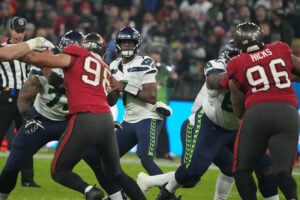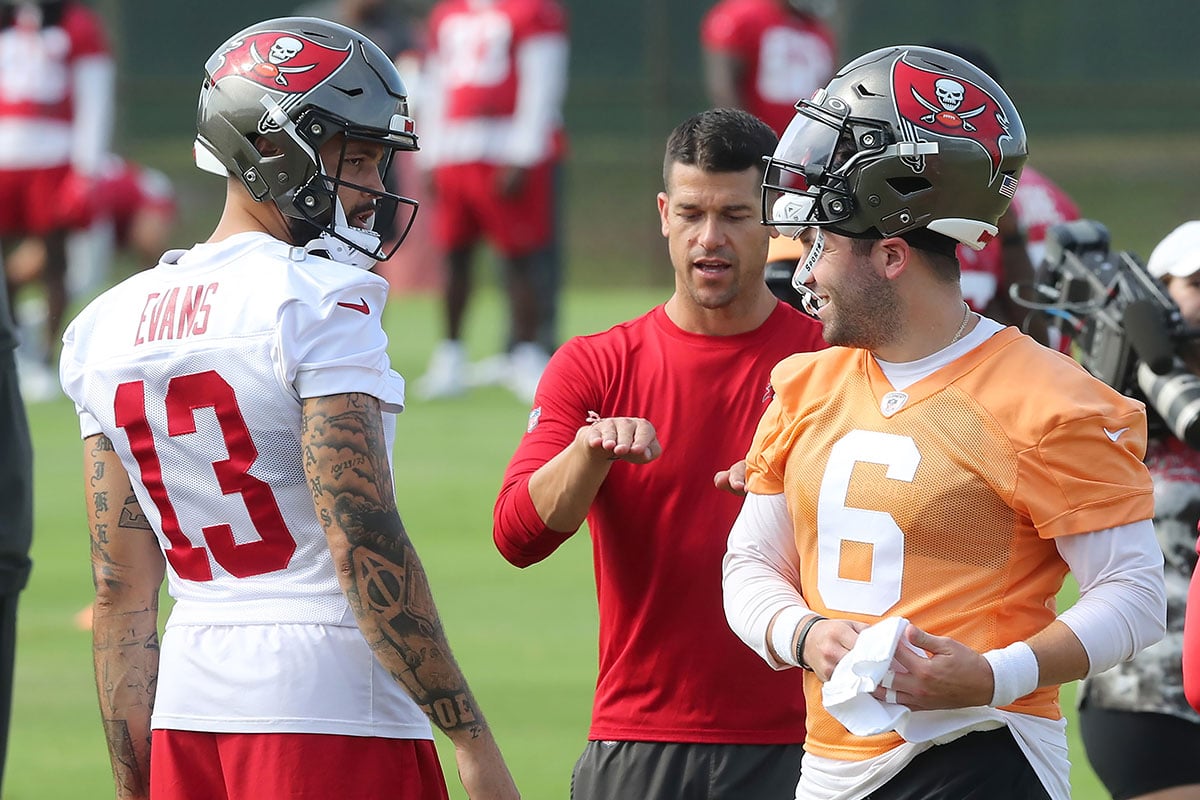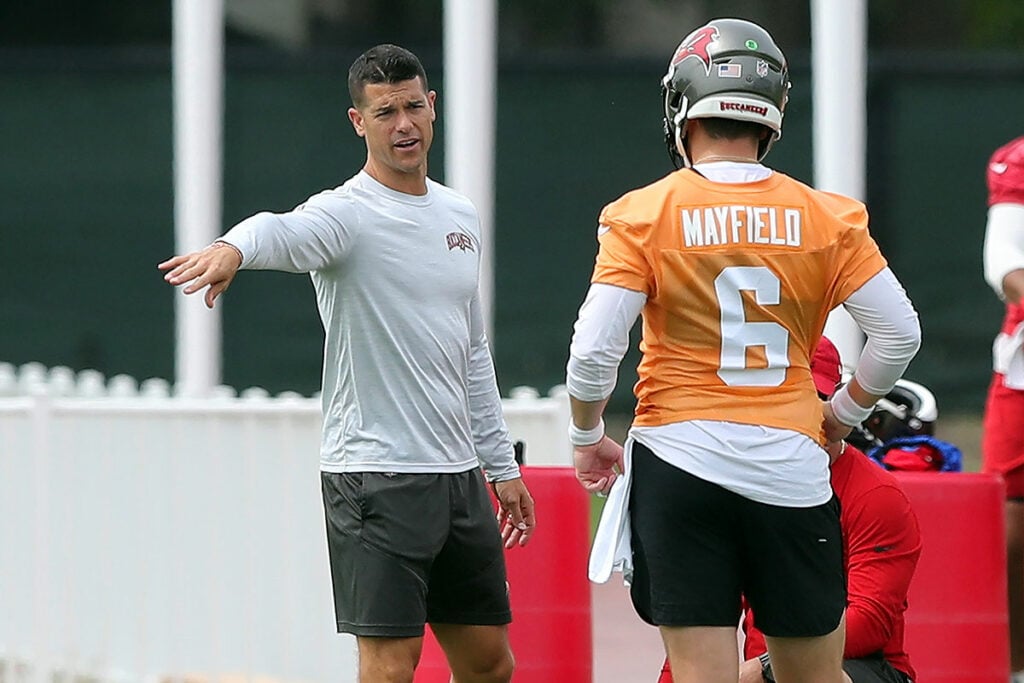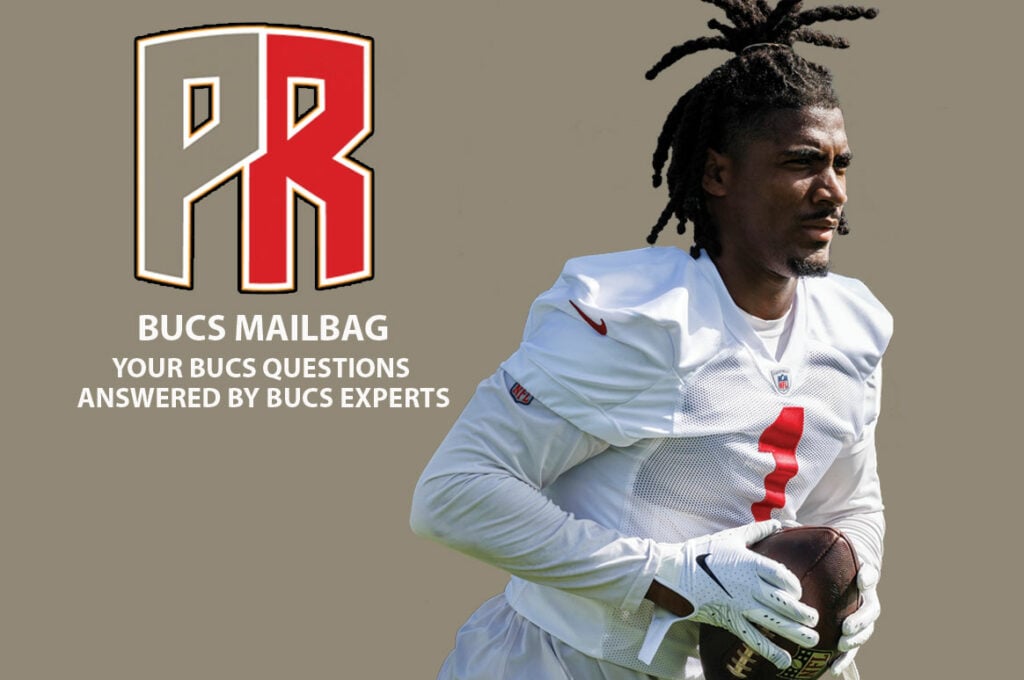At this point we all know play-action passing is a bit of a cheat code. As they say, “the numbers don’t lie,” and almost every quarterback’s numbers go way up when they have the benefit of slowing the opposing defense down with play-action. On his recent appearance on the Pewter Report Podcast, Bucs offensive coordinator Dave Canales was asked about his philosophy regarding play-action and if he had an ideal amount that he would like to use it.
“Honestly I would say you’re going to probably get three-to-five great play action shots a game,” Canales said. “That’s out of 60-some odd plays. So it’s not that much. But you’re waiting for the right opportunity. You’re waiting for them to put the gloves down and then it’s like the knockout punch right. You think about a boxing match. And that’s what I always say about Russell [Wilson]. He was such a heavyweight fighter because he was so patient, he was so patient, and then he would run [the ball]. And they’re like, ‘Why is he running all the time? Because he didn’t get the right look. And then they would be flat-footed at safety and he would launch it to Tyler [Lockett] or DK [Metcalf] for a 60-yard, 40-yard, 35-yard bomb.

Seahawks QB Geno Smith – Photo by: USA Today
“And it was like a heavyweight fight. How many real knockout punches happen? Three-to-five. It’s not haymaker after haymaker. It’s like you’re on the card, you’re on the card, you’re on the card, you made a mistake – boom! He goes to the ground. Did he get up? That’s the feel of it. That’s the ‘why’ behind the tempo. That’s the ‘why’ behind the run game and being able to play to our strengths – keep [our] defense on the sideline. Let them rest. It’s quick completion. Don’t get tired, throw that flat again. Throw that flat again. The clock’s ticking. The defense is sitting there. The runs … slowly … okay, they’re starting to inch up. Somebody tell me. Okay, we’re ready – and then boom! You try to hit them that way.”
Canales’ answer was very nuanced. While he didn’t say exactly how many times he would like to run play-action per game or season he really broke down in great detail what he is hoping to accomplish with play-action. Last year the Seahawks starting quarterback Geno Smith ranked eighth in the NFL in play action snaps with 172. On those drop backs he was 118-157 for 1,360 yards and eight touchdowns to four interceptions.
Smith carried an 8.7 yards per attempt on play-action throws while earning a 77.9 Pro Football Focus grade. On all other throws Smith was 306-450 for 3,175 yards with 24 touchdowns and eight interceptions, averaging 7.1 yards per attempt and earning a 76.6 PFF grade.
While the touchdown-to-interception ratio wasn’t as good during play-action look at the disparity of yards per attempt. The Seahawks averaged almost 23% more yards per play on play-action.
Averaging just a hair over 10 play-action plays per game last year, Canales still said he was hoping for three to five real “haymaker shots” by pulling the linebackers in. A great example of that from last year was Seattle’s Week 3 matchup against (Bucs division rival) Atlanta. In that game the Seahawks ran play action on nine of their 46 drop backs. It was an incredibly efficient and explosive part of their game, as Smith went 8-of-9 for 98 yards. But diving deeper into the specifics of each play and you start to see the detail of what Canales was peaking about.
Dave Canales Wants The Bucs QBs To Take The Check Down
Dave Canales came back to the play-action subject in a round-about way later in the Pewter Report Podcast, talking more about the non-shot plays that can still be beneficial to an offense.
“And then just like the [play-action] boot game, you know I tell my guys if you have a guy open in the flat, just take it,” Canales said. “He may get two yards. But guess what? All 11 on defense have to redirect from where they were, chase flat to the other side of the field and try to make the tackle. If the guy gets eight or nine [yards], you may have eight or nine guys chasing him down the field that far.”
There were several examples of this from that Week 3 matchup between Seattle and Atlanta.
Dave Canales Discusses The Importance Of QB Mobility
Dave Canales also spoke about how he wants his quarterbacks to handle play-action when they run naked boots and the defense is a bit more prepared than they expected. Canales spoke about that expectation within the context of discussing Bucs quarterback Kyle Trask’s mobility.
“I was pleasantly surprised by his mobility in the boot game,” Canales said. “Being able to pull up when he has a dirty edge. That’s just if you have a pressure or a defensive end plays out of it and he’s in your lap. To watch him be able to twitch up, find a platform and find a completion or throw it away. Those are some of the things I didn’t know I was getting, but he handled it great and we drilled the heck out of it.”
You can see what Canales is talking about on this play-action pass Seattle quarterback Geno Smith executed on second-and-5 to help set up a third-and-very manageable.
Linebacker Troy Anderson commits to invading the backfield and trying to get to Smith on the half boot. This forces tight end Noah Fant coming across the formation on a fake split block to quickly get to the flat and present himself as a target. Smith is able to pull up and make a quick off-platform throw to Fant and create a short positive gain.
It happens later in the game in an almost identical way from shotgun. Again, Anderson comes off the edge to the field side and again Smith finds a way to get a throw off to the flat for a short gain.
Dave Canales Anticipates 3-5 Big Play-Action Shots Per Game
Dave Canales mentioned that the real goal with play-action is getting three-to-five big shots. Passing explosives in the NFL are defined as plays that go for 20 yards or more. How many of those opportunities did Seattle get against Atlanta? Would you be surprised to hear three to five? I didn’t think so.
It started early in the first half when they generated 36 yards on a deep corner route to tight end Colby Parkinson.
From a heavy run formation Seattle was able to catch Atlanta on a blitz and hot Parkinson for a huge gain deep into the red zone that eventually led to a touchdown.
On this second-and-5 from Seattle’s own 25-yard linem Smith has an opportunity to hit Tyler Lockett on this deep out for 19-20 yards. Smith is just a hair late on throwing Lockett open and the defense adjusts in time to break up the pass.
And then near the end of the game, down and on the final drive, when Atlanta knew the Seahawks couldn’t afford to run the ball, and yet they were still able to pull off one of the big shots Canales was talking about.
The play-action helped draw the linebackers in just enough to allow Lockett to get behind them on the deep cross.
Through Seattle’s actions last year and Canales’ words on the Pewter Report Podcast last week we get a clear idea of how he plans to deploy play-action in the Bucs’ new offense. About 9-10 total plays with the hope to create three to five explosives per game.
Watch Dave Canales On The Pewter Report Podcast
Check out the latest Pewter Report Podcast with Special Guest: Bucs OC Dave Canales by clicking the link below.
Josh Queipo joined the Pewter Report team in 2022, specializing in salary cap analysis and film study. In addition to his official role with the website and podcast, he has an unofficial role as the Pewter Report team’s beaming light of positivity and jokes. A staunch proponent of the forward pass, he is a father to two amazing children and loves sushi, brisket, steak and bacon, though the order changes depending on the day. He graduated from the University of South Florida in 2008 with a degree in finance.




